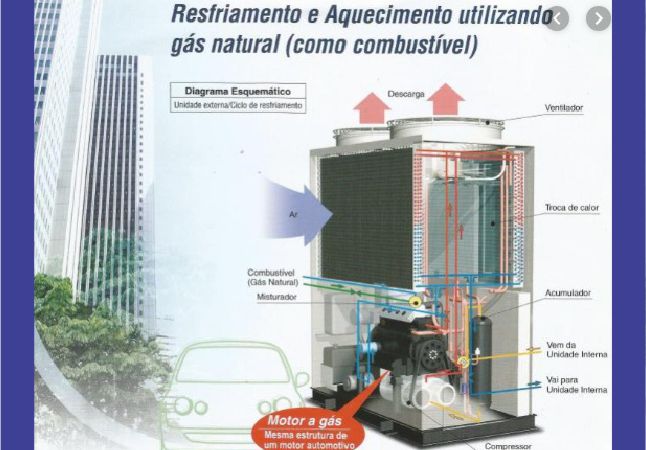The use of air conditioning systems powered by natural gas can lead to a reduction in electricity consumption between 91% and 99%, among several other advantages. This was the main highlight of the Sulgás VRF Natural Gas Seminar, held on Thursday (Nov 19) at the headquarters of ASBRAV – South Brazilian Association of Refrigeration, Air Conditioning, Heating and Ventilation, in Porto Alegre.
With lectures by specialists on the subject, the event presented the concept and application of VRF-type air conditioning systems powered by natural gas. Topics covered included the types of equipment available in the Brazilian market, recommended applications for the system, advantages and disadvantages of its use, energy efficiency, environmental impact, cost-benefit ratio, and return on investment.
The panelists pointed out that the equipment used in VRF air conditioning systems can be divided into Absorption Chillers and Gas Heat Pump (GHP) systems. The first operates by indirect expansion, meaning the refrigerant cools an intermediate medium—such as water—which then circulates through a coil that cools the air to be supplied into the environment. The second operates through both direct and indirect expansion. In direct expansion, the refrigerant absorbs heat directly from the air in the space to be conditioned. Heat rejection can occur through air condensation (without a cooling tower) or water condensation (with a cooling tower).
GHP (Gas Heat Pump) units are similar to EHP (Electric Heat Pump) systems, with the main difference being the type of energy used and the type of drive mechanism. In EHPs, an electric motor drives the compressor, whereas in GHPs, a natural gas internal combustion engine performs this mechanical work.
In addition to reducing electricity consumption, natural gas-powered air conditioning systems offer several other advantages: simultaneous hot water production, low noise levels, the use of smaller power generators, operation with eco-friendly refrigerants, lower operating and maintenance costs compared to conventional systems, and reduced investment in electrical infrastructure.
The first speaker at the event was Professor Paulo Otto Beyer, Director of Education and Training at ASBRAV, who highlighted the growing global use of this air conditioning technology as a replacement for electricity. According to him, this is due to two key advantages of the natural gas system.
The first advantage is the relief of the electrical system, as the use of natural gas reduces dependence on the power grid, lowers costs due to decreased contracted demand, and even eliminates peak-hour tariffs, which do not apply to natural gas.
The other interesting feature is that natural gas air conditioning can be used to produce both heating and cooling, according to the needs for heating, refrigeration, or a combination of both.
Mário Sérgio Almeida, from MSA Engenharia, noted that using GHP air conditioning systems also offers benefits such as application in systems requiring redundancy (electricity and natural gas), use of an eco-friendly gas like R410A, good performance in partial loads ranging from 10% to 100%, and the reduction in the size of the emergency generator.
Representatives from the three major natural gas air conditioning manufacturers—Panasonic, LG, and Yanmar—also spoke at the seminar. Daniel Fraianeli from LG Electronics, Maurício Iwayawa from Yanmar Toyota, and Márcio Rocha from Panasonic discussed the products their companies are offering consumers, highlighting the high technology integrated into natural gas air conditioning.
Representing the São Paulo Gas Company (Comgás), Ronaldo Andreo gave an overview of the company’s activities, which serves more than 1.4 million customers in the state of São Paulo, supplying natural gas to residences, businesses, industries, and vehicles.
The largest natural gas distributor in Brazil, Comgás serves more than 1.4 million customers in the state of São Paulo. It supplies natural gas to residences, businesses, industries, and vehicles, employing pioneering technological resources in the development of this sector.
According to Ronaldo, the segments where the benefits of GHP application are most noticeable are hospitals, universities, commercial offices, public agencies, clubs, gyms, and restaurants. According to him, these places have a large variation in the number of people, causing fluctuations in the intensity of the environment's climate control. The GHP system adapts well, consuming energy proportional to the thermal load.
Closing the seminar activities, Guilherme Garcez Cabral, representative of the Rio Grande do Sul State Gas Company – Sulgás, also explained the work the company carries out, highlighting that it currently serves more than 25,000 customers in 37 municipalities in Rio Grande do Sul, with a network spanning 890 kilometers.
He also thanked ASBRAV for the partnership in holding the seminar, which was a great opportunity to widely promote the benefits of using natural gas across various sectors of society.
Guilherme also gave a brief overview of shale gas, found in impermeable or low-permeability rocks. Shale gas is located at great depths, and its formations extend over several kilometers. Currently, the largest shale gas producer in the world is the United States, while in South America, Argentina holds the largest reserves.
The increase in the production of this gas in recent years has led to a price drop of around 15% compared to the year 2008.
